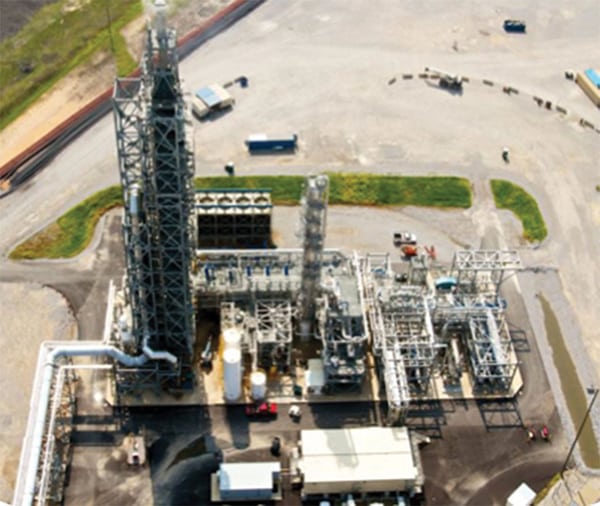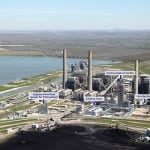Mitsubishi Heavy Industries Ltd. (MHI) and Southern Co. have completed the initial demonstration phase of a carbon capture and storage (CCS) test at the Plant Barry power station in Mobile, Ala.
The companies built a 25-MW carbon capture demonstration plant, consisting of a flue gas scrubber, flue gas carbon dioxide (CO2) capture/regeneration system, CO2 compression machinery, and electrical components, adjacent to the seven-unit James M. Barry Plant owned by Southern subsidiary Alabama Power (Figure 3). Notably, the facility employs the KM CDR Process, which uses a proprietary KS-1 high-performance solvent for CO2 absorption and desorption that was jointly developed by MHI and Japanese utility Kansai Electric Power Co. and is said to use less energy than comparable systems.
 |
| 3. A test plant. Mitsubishi Heavy Industries and Southern Co. have completed the initial demonstration phase of a carbon capture and storage test at Plant Barry in Mobile, Ala. Courtesy: Southern Co. |
Testing of the facility’s carbon capture capabilities, which the developers say is a “globally unprecedented” 500 metric tons per day (mtpd), began in June 2011. Integrated capture and sequestration demonstration testing began in August 2012. The test confirmed “[h]igh-performance continuous and stable operation of the large-scale CO2 recovery plant,” MHI said in a statement to POWER.
Southern Co. and MHI are now discussing additional demonstration phase activities using the plant. MHI also said it would “accelerate its program” that seeks to achieve commercially viable technology for recovering CO2 from the flue gas of coal-fired plants.
Richard Esposito of Southern Co.’s Advanced Energy Systems Research & Technology Management arm told the Wyoming Infrastructure Authority in January that the plant’s demonstration involves a 12-mile CO2 pipeline built by Denbury Resources as well as CO2 injection into a deep saline formation above the Citronelle Oil Field. So far, about 200,000 tons of CO2 has been captured (a recovery efficiency of above 90% at a purity of 99.97%) and 100,000 tons has been injected.
Southern Co. is meanwhile building a CCS-ready 582-MW integrated gasification combined cycle (IGCC) plant in Kemper County, Miss., that is expected to capture 65% of its CO2 emissions, most of which will be transported by a completed 60-mile pipeline and used for enhanced oil recovery. That plant is slated to go into operation later this year.
January also marked milestones for a number of federally backed CCS ventures. The Department of Energy (DOE) formally committed $1 billion to its long-stalled FutureGen 2.0 project proposed for Meredosia, Ill. That project, whose total estimated cost is $1.68 billion, seeks to upgrade a unit of Ameren Energy’s Meredosia Energy Center. The repowered 168-MWe unit will include oxycombustion and carbon capture technologies designed to capture at least 90% of its CO2 emissions during “steady state” operation.
The performance of CCS technology is also being tracked at the 400-MW Texas Clean Energy Project (TCEP) IGCC and 405-MW Hydrogen Energy California (HECA) IGCC facilities—but the future of both those projects is uncertain. TCEP and HECA are two of only three active DOE Round 3 Clean Coal Power initiative projects (the third is NRG Energy’s post-combustion demonstration at the W.A. Parish plant in Texas). San Antonio, Texas–based CPS Energy allowed a key power purchase agreement with Summit’s TCEP to expire at the end of 2013, citing delays and a changing energy landscape. California regulators are reviewing the HECA project. (For more on the TCEP and HECA projects, see “Is Polygeneration the Future for Clean Coal?” in this issue.)
—Sonal Patel, associate editor (@POWERmagazine, @sonalcpatel)









